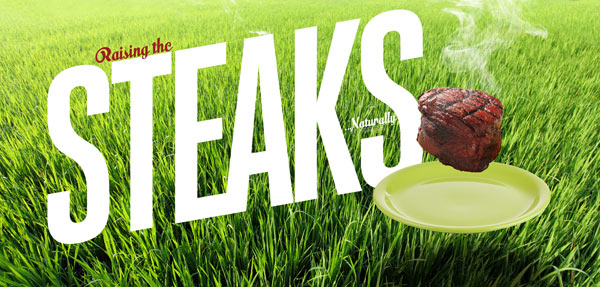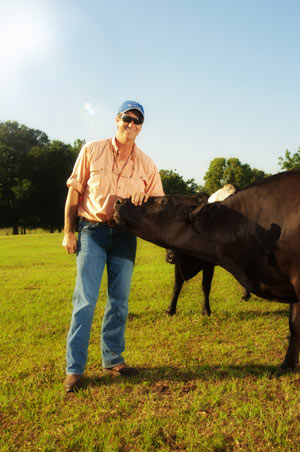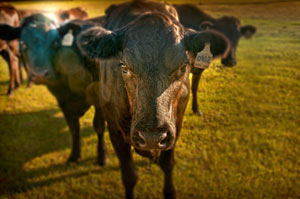
Mention Florida to someone in another state and they think ofbeaches, palm trees and Mickey Mouse. Florida has built a reputation as a “tourist state,” and while that’s certainly true, most people—including many Florida residents—don’t realize how dominant a role agriculture plays in the Sunshine State.
A staggering 9.25 million Florida acres are devoted to farming.
According to the Florida Department of Agriculture, Florida ranked No. 1 in the value of production of oranges in 2008. That might be expected, but the state also led in grapefruit, tangerines, sugarcane for sugar and seed, squash, watermelon, sweet corn, fresh-market snap beans, fresh-market tomatoes and fresh-market cucumbers.
Florida’s agricultural bounty doesn’t just grow on trees and vines. Cattle arrived on these shores in 1521 thanks to Spanish explorer Juan Ponce de Leon and have played a part in the area’s economy ever since. Florida ranks about 10th in the nation in number of beef cows, and breeding herd values total more than $847 million. The value of the calves produced by those herds is an additional $200 to $350 million.
Traditionally, Florida has been a cow/calf state when it comes to beef. Calves are the “crop.” Most farmers sell their weaned calves at six to eight months of age; the animals are then shipped out of state to feedlots where they are “finished.”
At feedlots, these young animals are kept in groups and grain fed until they reach the desired weight for slaughter, which is about 1,200 to 1,300 pounds. The cattle hit this weight at about 16 to 18 months of age, at which point they’re sent to processing plants for slaughter. Their meat is packaged and sent to retail markets across the country and around the world as “boxed beef.”
Commercial beef production is all about economics. “Pushing” the cattle with a high concentration grain ration, antibiotics and hormones allows them to be harvested at around 18 months of age instead of waiting until after they are 2 years old, which is when they would mature naturally.
Although today’s feedlots have greatly improved over the last 10 years, life in a feedlot is far from idyllic. Large numbers of cattle are confined to relatively small spaces. They have no grass for grazing and no opportunity to relax under the shade of a tree, napping in the sunshine as they chew their cuds. Instead, they are often walking through a slurry of mud and manure and are fed large amounts of grain, which is not how cattle are naturally designed to eat.
Because eating such a grain-heavy diet can cause health problems, feedlot cattle are typically given chemical additives and constant low levels of antibiotics. Some are also given growth hormones. Their feed may contain “by-product feedstuff,” which can range from stale bread and candy to chicken feathers and peanut hulls. Not exactly what you want to think of when you’re cutting into a thick, juicy steak.

“The grain and corn industry has gotten a bad rap, but it’s not necessarily the grain’s fault—it’s the way the system is designed to push (cattle) to gain weight rapidly,” explains cattleman Greg Mullen, co-owner of Artisan Cattle in Ocala. “The only way to make commercial beef reach their weight goal in that amount of time is to push the concentrate to them. When people hear beef is ‘grain fed,’ they think this is bad, but it’s not that the feedstuff is always bad, just the method being used.”
Most beef cattle in the U.S. are raised commercially and finished in feedlots, but over the past decade, American consumers have begun to seek alternatives. They still want to eat beef, but they want a healthier end product; they also want to know that the animals have had a good life from start to finish.
Grass-fed, pasture-raised beef has found a niche in the market. Granted, it’s a small niche at this point, but it’s expanding, and the Central Florida area is doing its part to make that happen.
Fortunately, for Florida beef growers, the state has a long growing season and produces an abundance of forage. Left to their own devices, cattle like to eat different things. In addition to grazing on grass, they will forage in the woods to eat berries, weeds and other plants.
It takes knowledge and careful management practices to raise grass-fed beef. Pastures must be kept in optimal condition and produce high-quality grasses and legumes, which requires extra effort and expense in fertilizer and rotation practices. The end result, however, is flavorful, tender, healthy beef for which consumers are willing to pay more for than what they can find at their local chain grocery store.
“We go from pasture to plate. It goes from start to finish on the same farm,” says Mullen, who, with business partner Mary Gary, started Artisan Cattle in 2007. Their business is a perfect example of the burgeoning grass-fed beef movement. The partners currently have about 200 head of cattle and raise Wagyu cattle, a Japanese breed known for their excellent yield grade, the highest percentage of monounsaturated fat (good fat, think olive oil) in all cattle breeds, fine meat texture and unsurpassed flavor, delivering an unforgettable dining experience.
Kobe beef comes from Wagyu cattle, but in order to be accurately called Kobe beef, it must come only from the Kobe region of Japan and meet very specific standards. In this country, we have both Fullblood Wagyu and American Wagyu (a cross between 100 percent fullblood Wagyu and another breed, such as Angus or Hereford), which is every bit as tender and desirable as the Japanese version. There are about 25,000 American Wagyu cattle and about 4,000 Fullblood Wagyu in the U.S.
Mullen was first introduced to Wagyu cattle when he lived in Southeast Asia and attended culinary school there 25 years ago. As he explains, “All Kobe beef comes from Wagyu cattle, but not all Wagyu cattle are Kobe beef. Currently, there is not any Kobe beef cattle product being exported from Japan because the tsunami and an outbreak of hoof and mouth disease has devastated their Wagyu industry.”
Mullen and Gary also own Artisinal Dish, a European-inspired market in Ocala. The primary reason for launching Dish was as a platform for promoting their beef, and that has definitely happened.
“We sell about 500 pounds of beef a week between retail sales and in-house use,” notes Mullen. “We also sell online and have a handful of wholesale accounts. Because our names are attached to it, we’ve very picky about which chefs or wholesale clients get it, so we’re mostly selling to ‘end users.’ Our goal is to produce the healthiest, best-tasting beef you can get your hands on. It might be more expensive than beef at your local chain grocery store, but it’s a much better product and better for you. It’s like comparing sweet apples and sour oranges.”
Grass-fed beef producers like Mullen and Gary have chosen to raise cattle this way for several reasons. They want to offer a healthier product, but they also got into the business because they truly like cattle and think they should be well treated every day of their lives… even though they’re being raised for meat.
“We see them every day; the care of our animals is first and foremost,” says Mullen.
Calves stay on pastures with their mothers until weaning at 6 months of age. After weaning, they’re separated into groups to be raised for meat or for breeding. Meat animals remain on pasture from start to finish, eating a fully vegetarian diet, until it’s time to harvest them at 26 to 28 months of age.

More and more “gentleman farmers” with small farms are getting into the beef business. Some intend to raise breeding stock to sell, while others want to raise their own steer for beef so they know exactly what the animal has eaten and how it’s been treated.
By next year, a new grass-fed beef business will be in full swing in our area. Adena Beef, owned by successful horseman Frank Stronach of Adena Springs Farm, is currently under construction in Ft. McCoy. Plans call for it to be fully operational by early 2013, processing hundreds of cattle per week in their state-of-the-art facility. At full production, the business will provide 100 to 150 jobs.
“Mr. Stronach feels strongly about how animals are raised and also feels strongly about eating healthier foods,” says general manager Mark Roberts. “These animals won’t be in feedlots. They’ll be in big, open fields until the day they’re harvested.”
Stronach has purchased vast amounts of land—over 25,000 acres in Ft. McCoy and over 30,000 acres in the Bronson area—to raise his cattle.
“We are slowly growing our herd. We already have 1,600 head of momma cows, and as we get land cleared, we are adding more,” said Roberts, noting that these cattle are primarily Angus with about one-quarter Brahma blood, which makes them better able to withstand heat and humidity.
“We will raise as much of our own as we can,” says Roberts. “If we can’t meet demand, then we would like to form partnerships with other beef farmers and either buy from them or have them raise cattle for us under certain standards. Our intent is to be almost totally grass fed.”
Raising steak on the hoof isn’t for everyone, but consumers have discovered a noticeable difference in the taste of locally raised, grass-fed beef compared to what’s available in most grocery stores.
“The beef we produce is gourmet restaurant quality,” notes Jan Costa, owner of Florida Fresh Meat Company in Summerfield. “Every animal is 100 percent pasture-raised, grass fed and grass finished, which means no grain whatsoever in the animals. They are also hormone and antibiotic free.”
Jan, who hails from a marketing background, originally started his shop with the idea of selling kosher meat. He knew that would be an easy sell, but his quandary was what to do with the remainder of the carcass, as anything behind the 12th rib is considered non-kosher. He faced a costly and wasteful dilemma until he decided to change tactics. He began investigating grass-fed beef, researching what was available in this area.
“I saw that was the way to go. I connected with farmers and told them I’d develop a market for the beef if they’d raise the cattle to maturity on grass. Now, instead of selling the calves at 6 to 8 months of age, they’re keeping them another 14 months.”
In January 2010, Costa started selling his products at farmers markets in Gainesville and Ocala. The response was enthusiastic. People loved the beef and started asking if he could provide locally raised, range-fed pork, lamb and chicken. Jan thought, why not?
In 2010, Florida Fresh Meat Company processed 20 steers; the following year, that number jumped to about 180. Today, the company offers top-quality USDA-inspected beef, lamb and pork through their Florida Department of Agriculture-licensed retail butcher shop located on the same premises as South Marion Meats, a USDA-inspected processing plant.
“You can’t have a smaller carbon footprint than that,” says Jan with a smile.
Indeed, all the meat sold in Jan’s shop is raised start to finish within a 150-mile radius of Ocala.
“We are involved from farm to plate. We have criteria the ranchers must meet. We engage in partnerships with local ranchers and farmers and pay good money for high-grade cattle. I visit each operation and see how the animals are raised,” says Jan, who’s interested in finding additional ranches that can supply the product he needs. “I always buy a sample animal to process before making a partnership with the ranch. I’m very particular and only want to sell the best.”
A majority of the beef sold by Florida Fresh Meat Company comes directly from the White Ranch in Citra. Dr. Ashley White has been raising cattle in Florida since 1990 and owns White Ranch with his wife Michele White.
“We were thinking of how we could help Florida by raising cattle for beef instead of selling calves,” says Dr. White, whose herd averages anywhere from 800 to 1000 head. “In Ocala, our native grasses are so healthy because of the limestone and minerals in the soil. We found we could raise healthy beef by going with grass fed.”
In addition to raising purebred Angus, Wagyu and Galloway beef, the White Ranch developed its own unique combination of breeds, which they refer to as “White Cross.” These cattle evolved from a carefully managed program that contains the best traits of several breeds: English Hereford, Red and Black Angus, Florida Brahman, Wagyu and Galloway. White Cross cattle can be 100 percent grass-fed on Florida forage and yield meat with the desirable high marbling of healthy fats.
After a steer is processed for Florida Fresh Meat Company, the carcass hangs to dry-age for up to 28 days. Enzymes in the meat tenderize it naturally during the aging period, and no tenderizing chemicals are used. The meat is then cut into roasts, steaks and hamburger and individually packed in vacuum bags for freshness.
“It’s a phenomenal product, and it’s aged, so it’s tender and the flavor is intensified,” notes Dr. White.
Jan is pleased to revive the concept of the friendly neighborhood butcher shop where meat is raised, processed and sold locally.
“We feed our community from within,” he says with satisfaction.
________________________________
Want to Learn More?






